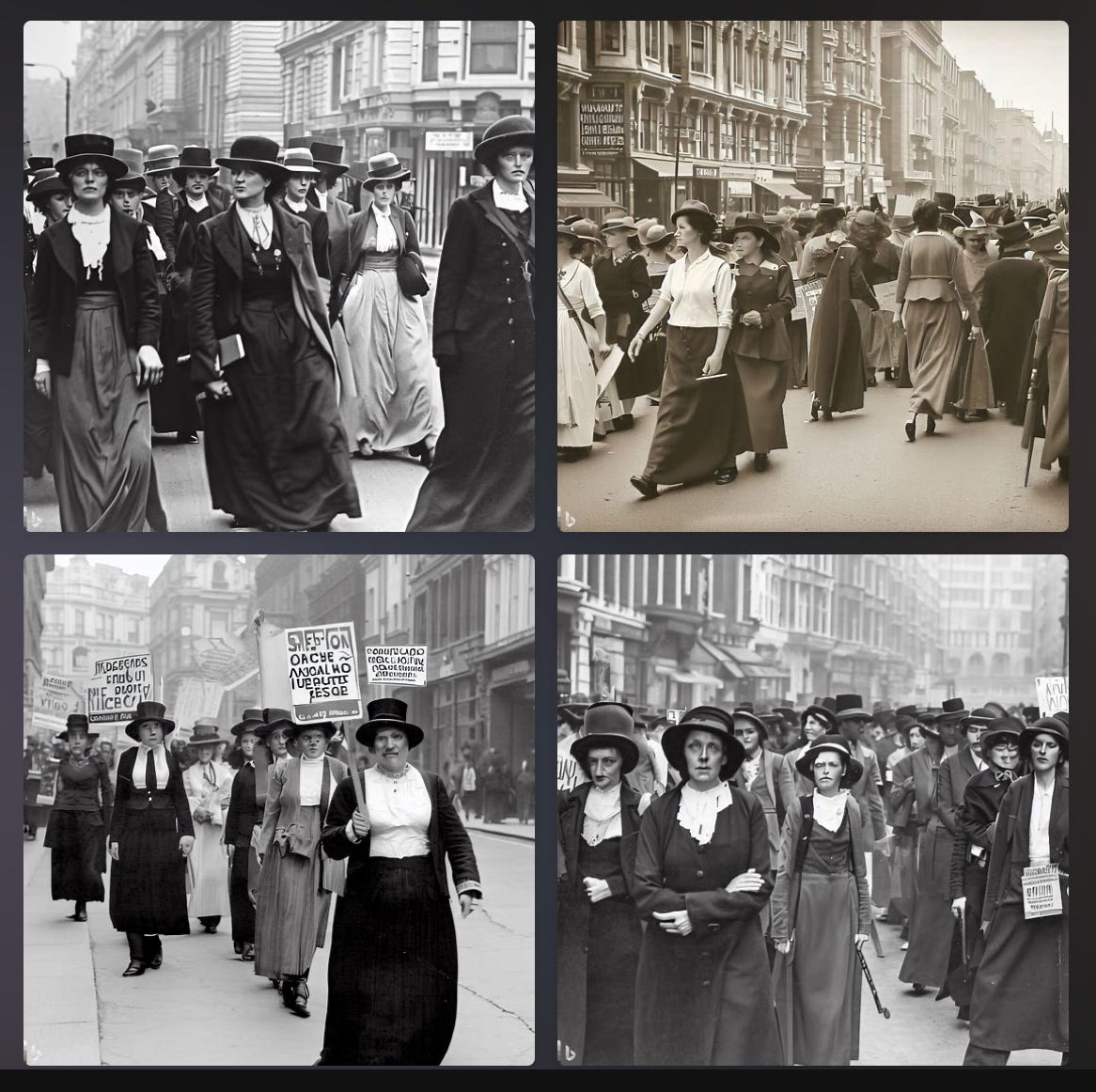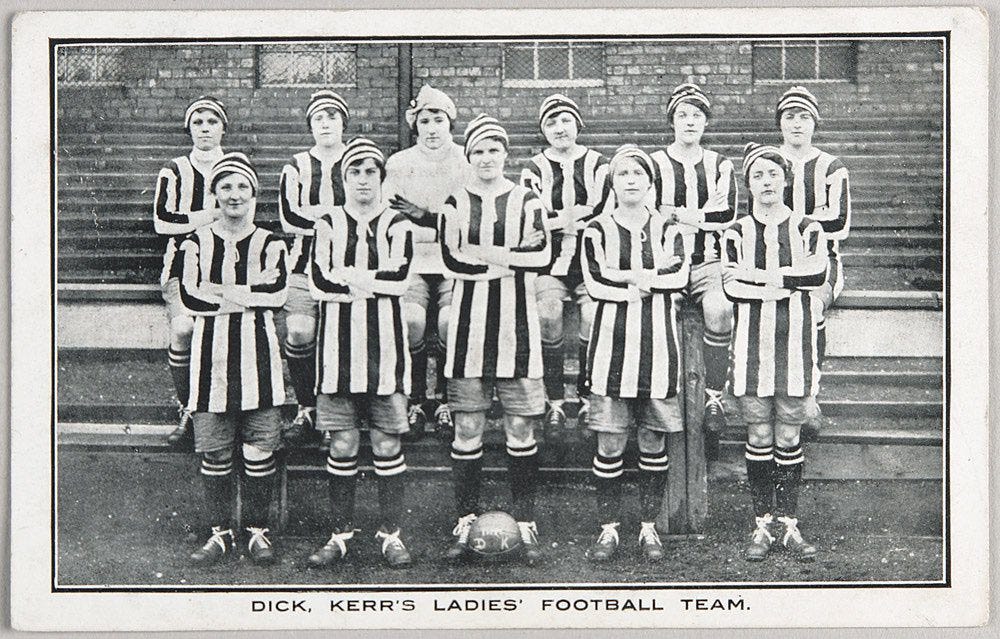On Women's Football and its decline in post war years
Men's football grew at the cost of gatekeeping women's football. This is a story from more than a century ago.
(Women playing football during World War I, as generated by Bing Image Creator.)
One of the many criticisms against the gender pay gap in sports includes how women’s sports are not that popular, and how men draw more crowds and well, the ‘market’ maketh the rules. What people often forget is how this popular narrative has been shaped by historical wrongdoings. Men’s football in the UK, for instance, grew at the cost of women’s football. To learn more about it, we have to travel more than a hundred years past.
Women's involvement in football during World War I is an inspiring and often overlooked aspect of the war's history. With many men away fighting in the trenches, women took on new roles in society, including working in factories, driving ambulances, and even playing football, which has primarily been the men’s domain. In the pre-war years, the suffragists, pioneered by Emmeline Pankhurst, were asking for women’s right to vote and football was seen as an effective instrument to challenge the traditional gender roles.
(Suffragettes on the streets of London in the early 20th century, generated by Bing Image Creator)
In 1914, just before the outbreak of World War I, the Women's Social and Political Union (WSPU), one of the leading suffragette organizations, formed its own women's football team called the Suffragettes FC. The team was made up of women who were members of the WSPU and who were committed to promoting women's rights through sport. The Suffragettes FC played its first match in London against a team of men and women, and it quickly became one of the most popular women's football teams in the country.
In England, women’s football became particularly popular during the war years. The Suffragettes FC played many matches during this time, and they used these matches as a platform to promote women's rights and suffrage. They often wore suffragette colours of purple, white, and green, and they sometimes carried banners and handed out leaflets to spectators. In 1915, the team played a match in front of 10,000 spectators at the Crystal Palace in London, and they raised money for the WSPU and other women's rights organizations.
Women's teams were established across the country, and matches were played in front of large crowds. The most famous women's team of the time was the Dick, Kerr Ladies, which was formed in Preston in 1917. The team was named after the engineering company where many of the players worked, and it quickly became one of the best-known women's football teams in the world.
The Dick, Kerr Ladies played their first match on Christmas Day 1917. The match was a huge success, and the team went on to play many more matches over the next few years. They played against other women's teams, as well as men's teams, and even toured the United States in 1922, where they played against some of the best women's football teams in the country.
The popularity of women's football during the war years was due in part to the fact that it provided a much-needed distraction from the horrors of war. Football was a source of entertainment and excitement, and it brought people together in a spirit of camaraderie and shared purpose. For women, playing football was a means of asserting their independence and autonomy.
However, women's football was not without its detractors. Many people, including some male football players, managers, and officials, saw it as a threat to the men's game. They argued that women's football was not as skilful or as entertaining as men's football and that it was not a suitable sport for women. Some even went so far as to say that women's football was dangerous and could cause women to become "unfeminine."
Despite these criticisms, women's football continued to thrive during the war years. Women's teams raised money for charity, and the Dick, Kerr Ladies alone raised over £150,000 for war-related causes. They also provided a much-needed source of entertainment and inspiration for women and men alike.
After the First World War, women's football faced a new obstacle as many men returned home from the war and found that women had taken on roles that were traditionally reserved for men, including playing football. This threatened the social order and gender norms of the time, which emphasized women's domesticity and subordination to men.
The connection between women's football and the suffragettes continued even after the war ended. In 1920, the Women's Football Association (WFA) was founded in England, and many of its members were suffragettes or women's rights activists. The WFA was committed to promoting women's football and challenging the idea that it was not a suitable sport for women.
That Boxing Day (26th December), Dick, Kerr Ladies played a match against St. Helens women’s team, to raise money for injured and out-of-work soldiers and sailors. According to a report published in The Guardian, over 45,000 spectators attended, at par with what high-profile men’s games would attract around the same time.
Yet, in 1921, the male-dominated Football Association (FA) banned women from playing football on FA-affiliated grounds, effectively putting an end to organized women's football in England. The FA claimed that the ban was necessary to protect the "best interests" of the game and to prevent women from getting injured.
The ban on women's football was controversial and generated considerable opposition from both women's football teams and women's groups. Many argued that women's football was a legitimate sport and that the ban was discriminatory and unfair. Despite this opposition, the ban remained in place for almost half a century.
One of the main arguments used to support the ban was that women's football was not suitable for women and could cause them physical harm. This argument was based on the belief that women were physically weaker than men and that playing football could lead to injuries and health problems. However, this argument was undermined by the fact that many women were already playing football for years, and there was virtually no evidence of serious injury in women’s football, except a report that one Florrie Redford had once been bitten on the ankle by a dog while playing.
Another argument used to support the ban was that women's football was not an attractive spectacle for spectators. This argument was based on the assumption that women were not as skilled or as entertaining as men when it came to playing football. However, this argument was also undermined by the fact that many women's football matches had drawn large crowds and had been played at a high level of skill.
The ban on women's football profoundly impacted the demographic’s involvement in the game in England. Women's teams disbanded, and many were forced to give up the sport they loved. Women continued to play informally, and teams sprang up in other countries where the ban did not exist.
It was not until the 1970s that the ban on women's football in England was grudgingly lifted. In 1971, the Women's Football Association (WFA) was established, and women's football was reintroduced on a small scale. However, it was not until the 1990s that women's football began to gain mainstream acceptance and recognition in England. By then, men’s football was already on the verge of reaching unprecedented heights.
Today, one might say women's football is a thriving sport, not only in England but also across the pond. However, the legacy of the ban on women's football is still felt, and at this point in time, it’s worth remembering how mainstream men’s football flew by locking the women’s game in a cage. Parallels can be drawn from similar fates women suffered in other areas of life. After all, this is an inherent societal issue and football is merely a subset of the larger culture.
A few resources:
A Woman's Game: The Rise, Fall and Rise Again of Women's Soccer by Suzanne Wrack (https://amzn.to/3TOy7eV)
A much more detailed analysis from an academic pov: https://www.tandfonline.com/doi/full/10.1080/17460263.2020.1726441
This is also a fine read:
https://www.fourfourtwo.com/features/the-rise-fall-and-rise-again-of-womens-football-a-140-year-history
(My substack is free of cost and will always remain so. However, if you like something I post here, do share it in your respective circles and kindly ask your friends to do the same.)





